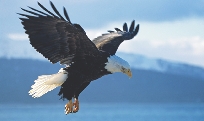The U.S. Fish and Wildlife Service (FWS) is the government agency in charge of enforcing the Endangered Species Act. Many of the scientists at FWS study threatened and endangered plants and animals by tracking the populations of the species on the list.
For example, the bald eagle used to be listed as an endangered species. In 1963, there were only 400 pairs left. By 1995, after many recovery efforts, the bald eagle population increased enough for the FWS to reclassify the bald eagle from “endangered” to “threatened.” Due to government and volunteer efforts, there are about 10,000 pairs today. Thus, the bald eagle has now been removed from the endangered and threatened species list.
The scientists at FWS have a challenging job. They need to protect all the species on the list. Even so, there are always more species in need of protection.
Organizations and individuals try to protect endangered species as well. Zoos and aquariums often work together. They breed and raise rare and endangered animals. Botanical gardens and other groups raise rare and endangered plants. They also save their seeds. In this way, the plants won’t disappear.
Not everyone agrees on the best way to help endangered species, especially when people’s jobs or way of life may be threatened. Like so many cases involving endangered species, survival means balancing the protection of endangered species with people’s way of life.

On June 28, 2007, the bald eagle was taken off the Federal List of Endangered and Threatened Wildlife and Plants. The bald eagle will still be protected by the Bald and Golden Eagle Protection Act.